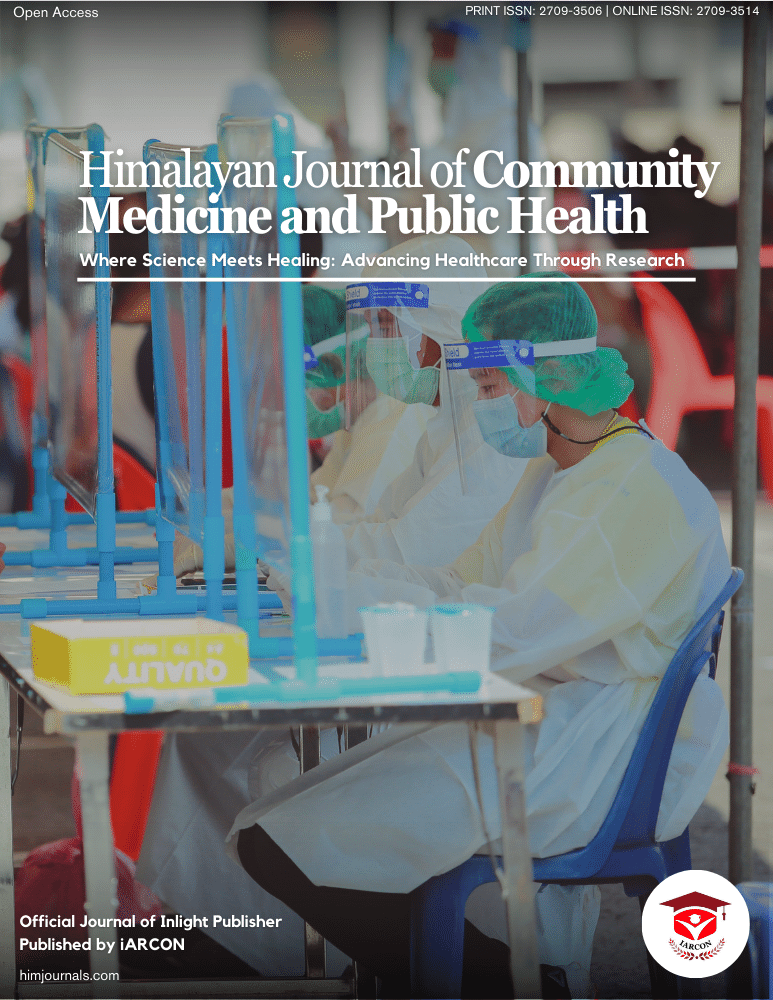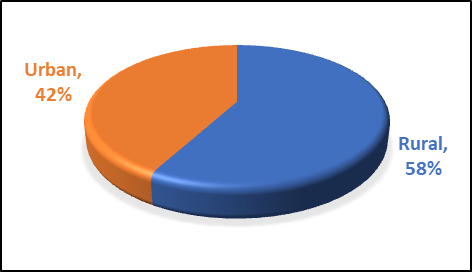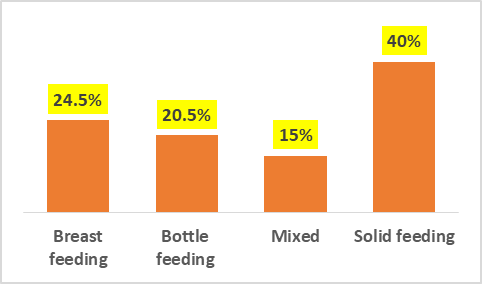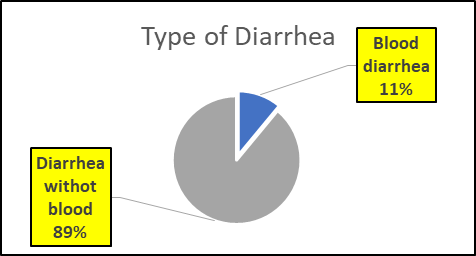Kliegman RM, Lye PS, Bordini BJ, Toth H, Basel D. Nelson Pediatric Symptom-Based Diagnosis E-Book. Elsevier Health Sciences; 2017 Mar 8.
Horn LM, Hajat A, Sheppard L, Quinn C, Colborn J, Zermoglio MF, Gudo ES, Marrufo T, Ebi KL. Association between precipitation and diarrheal disease in Mozambique. International journal of environmental research and public health. 2018 Apr;15(4):709.
D Levine GA, Walson JL, Atlas HE, Lamberti LM, Pavlinac PB. Defining pediatric diarrhea in low-resource settings. Journal of the Pediatric Infectious Diseases Society. 2017 Sep 1;6(3):289-93.
Duong VT, Tuyen HT, Van Minh P, Campbell JI, Phuc HL, Nhu TD, Tu LT, Chau TT, Nhi LT, Hung NT, Ngoc NM. No clinical benefit of empirical antimicrobial therapy for pediatric diarrhea in a high-usage, high-resistance setting. Clinical Infectious Diseases. 2018 Feb 1;66(4):504-11.
Wu W, Shen N, Luo L, Deng Z, Chen J, Tao Y, Mo X, Cao Q. Fecal microbiota transplantation before hematopoietic stem cell transplantation in a pediatric case of chronic diarrhea with a FOXP3 mutation. Pediatrics & Neonatology. 2021 Mar 1;62(2):172-80.
Guarino A, Vecchio AL, Dias JA, Berkley JA, Boey C, Bruzzese D, Cohen MB, Cruchet S, Liguoro I, Salazar-Lindo E, Sandhu B. Universal recommendations for the management of acute diarrhea in nonmalnourished children. Journal of pediatric gastroenterology and nutrition. 2018 Nov 1;67(5):586.
Zhou Y, Zhu X, Hou H, Lu Y, Yu J, Mao L, Mao L, Sun Z. Characteristics of diarrheagenic Escherichia coli among children under 5 years of age with acute diarrhea: a hospital based study. BMC infectious diseases. 2018 Dec;18(1):1-0.
Florez ID, Veroniki AA, Al Khalifah R, Yepes-Nuñez JJ, Sierra JM, Vernooij RW, Acosta-Reyes J, Granados CM, Pérez-Gaxiola G, Cuello-Garcia C, Zea AM. Comparative effectiveness and safety of interventions for acute diarrhea and gastroenteritis in children: a systematic review and network meta-analysis. PLoS One. 2018 Dec 5;13(12):e0207701.
Adane M, Mengistie B, Medhin G, Kloos H, Mulat W. Piped water supply interruptions and acute diarrhea among under-five children in Addis Ababa slums, Ethiopia: A matched case-control study. PloS one. 2017 Jul 19;12(7):e0181516.
Anteneh ZA, Andargie K, Tarekegn M. Prevalence and determinants of acute diarrhea among children younger than five years old in Jabithennan District, Northwest Ethiopia, 2014. BMC public health. 2017 Dec;17(1):1-8.
Cox FE. Concomitant infections, parasites and immune responses. Parasitology. 2001 Mar;122(S1):S23-38.
Harb A, Abraham S, Rusdi B, Laird T, O’Dea M, Habib I. Molecular detection and epidemiological features of selected bacterial, viral, and parasitic enteropathogens in stool specimens from children with acute diarrhea in Thi-Qar Governorate, Iraq. International journal of environmental research and public health. 2019 Jan;16(9):1573.
Lu T, Yin L, Chen R, Zhang H, Cai J, Li M, Dai L, Zhu C, Zhang Y, Xiang F, Wang L. Chinese pediatric Tuina on children with acute diarrhea: a randomized sham-controlled trial. Health and quality of life outcomes. 2021 Dec;19(1):1-1.
Zhou SX, Wang LP, Liu MY, Zhang HY, Lu QB, Shi LS, Ren X, Wang YF, Lin SH, Zhang CH, Geng MJ. Characteristics of diarrheagenic Escherichia coli among patients with acute diarrhea in China, 2009‒2018. Journal of Infection. 2021 Aug 3.
Anteneh ZA, Andargie K, Tarekegn M. Prevalence and determinants of acute diarrhea among children younger than five years old in Jabithennan District, Northwest Ethiopia, 2014. BMC public health. 2017 Dec;17(1):1-8.
Abuzerr S, Nasseri S, Yunesian M, Hadi M, Zinszer K, Mahvi AH, Nabizadeh R, Abu Mustafa A, Mohammed SH. Water, sanitation, and hygiene risk factors of acute diarrhea among children under five years in the Gaza Strip. Journal of Water, Sanitation and Hygiene for Development. 2020 Mar 1;10(1):111-23.
Adane M, Mengistie B, Mulat W, Medhin G, Kloos H. The most important recommended times of hand washing with soap and water in preventing the occurrence of acute diarrhea among children under five years of age in slums of Addis Ababa, Ethiopia. Journal of community health. 2018 Apr;43(2):400-5.
Hines RL, Marschall K. Stoelting's anesthesia and co-existing Disease. Elsevier Health Sciences; 2008 Jun 5.
Getachew B, Mengistie B, Mesfin F, Argaw R. Factors associated with acute diarrhea among children aged 0-59 months in Harar town, eastern Ethiopia. East African Journal of Health and Biomedical Sciences. 2018 Nov 8;2(1):26-35.
Guarino A, Vecchio AL, Dias JA, Berkley JA, Boey C, Bruzzese D, Cohen MB, Cruchet S, Liguoro I, Salazar-Lindo E, Sandhu B. Universal recommendations for the management of acute diarrhea in nonmalnourished children. Journal of pediatric gastroenterology and nutrition. 2018 Nov 1;67(5):586.
Zhou Y, Zhu X, Hou H, Lu Y, Yu J, Mao L, Mao L, Sun Z. Characteristics of diarrheagenic Escherichia coli among children under 5 years of age with acute diarrhea: a hospital based study. BMC infectious diseases. 2018 Dec;18(1):1-0.
Florez ID, Veroniki AA, Al Khalifah R, Yepes-Nuñez JJ, Sierra JM, Vernooij RW, Acosta-Reyes J, Granados CM, Pérez-Gaxiola G, Cuello-Garcia C, Zea AM. Comparative effectiveness and safety of interventions for acute diarrhea and gastroenteritis in children: a systematic review and network meta-analysis. PLoS One. 2018 Dec 5;13(12):e0207701.
Yang B, Lu P, Li MX, Cai XL, Xiong WY, Hou HJ, Ha XQ. A meta-analysis of the effects of probiotics and synbiotics in children with acute diarrhea. Medicine. 2019 Sep;98(37)..
Li YT, Xu H, Ye JZ, Wu WR, Shi D, Fang DQ, Liu Y, Li LJ. Efficacy of Lactobacillus rhamnosus GG in treatment of acute pediatric diarrhea: A systematic review with meta-analysis. World journal of gastroenterology. 2019 Sep 7;25(33):4999.
Shrivastava AK, Kumar S, Mohakud NK, Suar M, Sahu PS. Multiple etiologies of infectious diarrhea and concurrent infections in a pediatric outpatient-based screening study in Odisha, India. Gut pathogens. 2017 Dec;9(1):1-2.
Tian Y, Chughtai AA, Gao Z, Yan H, Chen Y, Liu B, Huo D, Jia L, Wang Q, MacIntyre CR. Prevalence and genotypes of group A rotavirus among outpatient children under five years old with diarrhea in Beijing, China, 2011–2016. BMC infectious diseases. 2018 Dec;18(1):1-1.
Wasihun AG, Dejene TA, Teferi M, Marugán J, Negash L, Yemane D, McGuigan KG. Risk factors for diarrhoea and malnutrition among children under the age of 5 years in the Tigray Region of Northern Ethiopia. PLoS One. 2018 Nov 26;13(11):e0207743..
Burnett E, Parashar UD, Tate JE. Global impact of rotavirus vaccination on diarrhea hospitalizations and deaths among children< 5 years old: 2006–2019. The Journal of infectious diseases. 2020 Nov 15;222(10):1731-9.
Reiner Jr RC, Graetz N, Casey DC, Troeger C, Garcia GM, Mosser JF, Deshpande A, Swartz SJ, Ray SE, Blacker BF, Rao PC. Variation in childhood diarrheal morbidity and mortality in Africa, 2000–2015. New England Journal of Medicine. 2018 Sep 20;379(12):1128-38.
Boadi KO, Kuitunen M. Childhood diarrheal morbidity in the Accra Metropolitan Area, Ghana: socio-economic, environmental and behavioral risk determinants. Journal of Health & Population in Developing Countries. 2005 Mar 15;7(1):15-22.
Bitew BD, Woldu W, Gizaw Z. Childhood diarrheal morbidity and sanitation predictors in a nomadic community. Italian journal of pediatrics. 2017 Dec;43(1):1-8.
Solomon ET, Gari SR, Kloos H, Mengistie B. Diarrheal morbidity and predisposing factors among children under 5 years of age in rural East Ethiopia. Tropical Medicine and Health. 2020 Dec;48(1):1-0.
Solomon ET, Gari SR, Kloos H, Mengistie B. Diarrheal morbidity and predisposing factors among children under 5 years of age in rural East Ethiopia. Tropical Medicine and Health. 2020 Dec;48(1):1-0.
Bennett JE, Dolin R, Blaser MJ. Mandell, Douglas, and Bennett's Principles and Practice of Infectious Diseases: 2-Volume Set. Elsevier Health Sciences; 2014 Aug 28.
Baro M, Deubel TF. Persistent hunger: Perspectives on vulnerability, famine, and food security in sub-Saharan Africa. Annu. Rev. Anthropol.. 2006 Oct 21;35:521-38.
Musaiger AO, Hassan AS, Obeid O. The paradox of nutrition-related diseases in the Arab countries: the need for action. International journal of environmental research and public health. 2011 Sep;8(9):3637-71.
Atnafu A, Sisay MM, Demissie GD, Tessema ZT. Geographical disparities and determinants of childhood diarrheal illness in Ethiopia: further analysis of 2016 Ethiopian Demographic and Health Survey. Tropical Medicine and Health. 2020 Dec;48(1):1-2.
Baral R, Nonvignon J, Debellut F, Agyemang SA, Clark A, Pecenka C. Cost of illness for childhood diarrhea in low-and middle-income countries: a systematic review of evidence and modelled estimates. BMC public health. 2020 Dec;20:1-3.
Alene M, Yismaw L, Berelie Y, Kassie B. Health care utilization for common childhood illnesses in rural parts of Ethiopia: evidence from the 2016 Ethiopian demographic and health survey. BMC public health. 2019 Dec;19(1):1-2.
Richard SA, McCormick BJ, Seidman JC, Rasmussen Z, Kosek MN, Rogawski ET, Petri W, Bose A, Mduma E, Maciel BL, Chandyo RK. Relationships among common illness symptoms and the protective effect of breastfeeding in early childhood in MAL-ED: an eight-country cohort study. The American journal of tropical medicine and hygiene. 2018 Mar;98(3):904.
Alexander E, Hommeida S, Stephens MC, Manini ML, Absah I. The role of oral administration of immunoglobulin in managing diarrheal illness in immunocompromised children. Pediatric Drugs. 2020 Jun 1;22(3):331-4.
Fissehaye T, Damte A, Fantahun A, Gebrekirstos K. Health care seeking behaviour of mothers towards diarrheal disease of children less than 5 years in Mekelle city, North Ethiopia. BMC research notes. 2018 Dec;11(1):1-7.
Keto T, Alemu Y, Mamo A. Mothers’ perception and management preference of acute diarrheal disease. Int J Public Health. 2020 Dec;9(4):338-46.
Sarker AR, Sultana M, Mahumud RA, Ali N, Huda TM, Haider S, Rahman H, Islam Z, Khan JA, Van Der Meer R, Morton A. Economic costs of hospitalized diarrheal disease in Bangladesh: a societal perspective. Global health research and policy. 2018 Dec;3(1):1-2.
UNICEF. Multiple indicator survey. United Nations Children’s Fund 2000; 3.
V Kendall C. Public health and the domestic domain: lessons from anthropological research on diarrheal diseases. InAnthropology and primary health care 2019 Mar 7 (pp. 173-195). Routledge.
Mohmed EA, Abdalla MA. Awareness and Knowledge of Mothers Regarding Home Management of Diarrheal Disease for Children Less Than Five. International Journal of Healthcare and Medical Sciences. 2021;7(3):58-62.
Andualem Z, Dagne H, Taddese AA, Dagnew B. Mothers’ Handwashing Knowledge as a Predictor of Diarrheal Disease Among Under-Five Children Visiting Pediatric Ward in University of Gondar Comprehensive Specialized Hospital, Northwest Ethiopia, 2019. Pediatric health, medicine and therapeutics. 2019;10:189.
Alghadeer S, Syed W, Alhossan A, Alrabiah Z, Babelghaith SD, Al Arifi MN, Alwhaibi A. Assessment of Saudi Mother’s Knowledge and Attitudes towards Childhood Diarrhea and Its Management. International Journal of Environmental Research and Public Health. 2021 Jan;18(8):3982.
Dev R, Williams-Nguyen J, Adhikari SP, Dev U, Deo S, Hillan E. Impact of maternal decision-making autonomy and self-reliance in accessing health care on childhood diarrhea and acute respiratory tract infections in Nepal. Public Health. 2021 Sep 1;198:89-95.
Tsehay CT, Aschalew AY, Dellie E, Gebremedhin T. Feeding Practices and Associated Factors During Diarrheal Disease Among Children Aged Less Than Five Years: Evidence from the Ethiopian Demographic and Health Survey 2016. Pediatric Health, Medicine and Therapeutics. 2021;12:69.
Rosyida DA, Hidayatunnikmah N. Maternal Attitude in the Handling of Diarrhea in Infant. Jurnal Medicoeticolegal Dan Manajemen Rumah Sakit. 2020 Apr 27;9(1):23-9.
King CK, Glass R, Bresee JS, Duggan C. Managing acute gastroenteritis among children: oral rehydration, maintenance, and nutritional therapy. MMWR Recomm Rep. 2003;52(RR-16):1-16.
WHO. Infant and young child feeding counseling: An integrated course. World Health Organization; 2006.
Shine S, Muhamud S, Adanew S, Demelash A, Abate M. Prevalence and associated factors of diarrhea among under-five children in Debre Berhan town, Ethiopia 2018: a cross sectional study. BMC infectious diseases. 2020 Dec;20(1):1-6.
Soboksa NE, Gari SR, Hailu AB, Alemu BM. Association between microbial water quality, sanitation and hygiene practices and childhood diarrhea in Kersa and Omo Nada districts of Jimma Zone, Ethiopia. PloS one. 2020 Feb 19;15(2):e0229303.
Belongia EA, Chyou PH, Greenlee RT, Perez-Perez G, Bibb WF, DeVries EO. Diarrhea incidence and farm-related risk factors for Escherichia coli O157: H7 and Campylobacter jejuni antibodies among rural children. The Journal of infectious diseases. 2003 May 1;187(9):1460-8.
Shemal AH. Epidemiology Of Diarrheal Diseases in Children Below 5 Years in Wassit Province. Al-Qadisiyah Medical Journal. 2014;10(17):141-7.
Abdul-hussein ZK, Raheema RH, Inssaf AI. Molecular diagnosis of diarrheagenic E. coli infections among the pediatric patients in Wasit Province, Iraq. Journal of Pure and Applied Microbiology. 2018 Dec 1;12(4):2229-41.
Hussein AA. Diarrhea among under-five Years children in Mosul City: Epidemiological and Microbiological study. Pak. J. Med. Health Sci. 2020;14(2):1060-3.
Tegen D, Damtie D, Hailegebriel T. Prevalence and Associated Risk Factors of Human Intestinal Protozoan Parasitic Infections in Ethiopia: A Systematic Review and Meta-Analysis. Journal of parasitology research. 2020 Oct 5;2020.
Mahal SS, Al-Omashi GB. Molecular Diagnosis and Genotype Analysis of Giardia lambelia in Diarrheal Patient in Al-Diwaniyah Province-Iraq. Indian Journal of Forensic Medicine & Toxicology. 2021 Apr 1;15(2).
Thiam S, Sy I, Schindler C, et al. Knowledge and practices of mothers and caregivers on diarrhoeal management among under 5-year-old children in a medium-size town of Senegal. Acta tropica 2019; 194: 155-64.
Ghasemi AA, Talebian A, Masoudi Alavi N, Moosavi GA. Knowledge of mothers in management of diarrhea in under-five children, in kashan, iran. Nurs midwifery stud. 2013;1(3):158-62.
Ehlayel MS, Bener A, Abdulrahman HM. Protective effect of breastfeeding on diarrhea among children in a rapidly growing newly developed society. Turk J Pediatr. 2009 Nov 1;51(6):527-33.
Alelign T, Asegidew W, Abera A. A cross sectional study on the incidence and risk factors of diarrheal illness among children under-five years of age in Debre Berhan town, Ethiopia. J Health Med Econ. 2016;2(2).
Alebel A, Tesema C, Temesgen B, Gebrie A, Petrucka P, Kibret GD. Prevalence and determinants of diarrhea among under-five children in Ethiopia: a systematic review and meta-analysis. PloS one. 2018 Jun 28;13(6):e0199684.
Megersa S, Benti T, Sahiledengle B. Prevalence of diarrhea and its associated factors among under-five children in open defecation free and non-open defecation free households in Goba District Southeast Ethiopia: a comparative cross-sectional study. Clinics Mother Child Health. 2019;16:324.
Getachew B, Mengistie B, Mesfin F, Argaw R. Factors associated with acute diarrhea among children aged 0-59 months in Harar town, eastern Ethiopia. East African Journal of Health and Biomedical Sciences. 2018 Nov 8;2(1):26-35.
Thabit MF, Hussian RR. Acute Infective Bloody Diarrhea in Children Below Five Years Admitted to Children Welfare Hospital in Medical City-Baghdad During 2015. Medico Legal Update. 2020 Apr 9;20(1):841-6.
Shrestha S, Aihara Y, Bhattarai AP, Bista N, Kondo N, Futaba K, Nishida K, Shindo J. Development of an objective water security index and assessment of its association with quality of life in urban areas of developing countries. SSM-population Health. 2018 Dec 1;6:276-85.
Komarulzaman A, Smits J, de Jong E. Clean water, sanitation and diarrhoea in Indonesia: Effects of household and community factors. Global public health. 2017 Sep 2;12(9):1141-55.
Otsuka Y, Agestika L, Widyarani NS, Yamauchi T. Risk factors for undernutrition and diarrhea prevalence in an urban slum in Indonesia: Focus on water, sanitation, and hygiene. The American journal of tropical medicine and hygiene. 2019 Mar;100(3):727.
Trudeau J, Aksan AM, Vásquez WF. Water system unreliability and diarrhea incidence among children in Guatemala. International journal of public health. 2018 Mar;63(2):241-50.
Alnawajha SK, Bakry GA, Aljeesh YI. Predictors of acute diarrhoea among hospitalized children in Gaza Governorates: a case-control study. Journal of health, population, and nutrition. 2015 Mar;33(1):1.
Boakye-Ansah AS, Ferrero G, Rusca M, Van Der Zaag P. Inequalities in microbial contamination of drinking water supplies in urban areas: the case of Lilongwe, Malawi. Journal of Water and Health. 2016 Oct;14(5):851-63.
Desta BK, Assimamaw NT, Ashenafi TD. Knowledge, practice, and associated factors of home-based management of diarrhea among caregivers of children attending under-five clinic in Fagita Lekoma District, Awi Zone, Amhara Regional State, Northwest Ethiopia, 2016. Nursing research and practice. 2017 Aug 21;2017.
Workie HM, Sharifabdilahi AS, Addis EM. Mothers’ knowledge, attitude and practice towards the prevention and home-based management of diarrheal disease among under-five children in Diredawa, Eastern Ethiopia, 2016: a cross-sectional study. BMC pediatrics. 2018 Dec;18(1):1-9.
Agegnehu MD, Bewket Zeleke L, Goshu YA, Ortibo YL, Mehretie Adinew Y. Diarrhea prevention practice and associated factors among caregivers of under-five children in Enemay District, Northwest Ethiopia. Journal of environmental and public health. 2019 May 12;2019.
Kebede Fufa W, Berhe Gebremedhin G, Gebregergs GB, Marama Mokonnon T. Assessment of poor home management practice of diarrhea and associated factors among caregivers of under-five years children in urban and rural residents of Doba Woreda, Ethiopia: Comparative cross-sectional study. International journal of pediatrics. 2019 Jun 2;2019.
Dodicho T. Knowledge and practice of mothers/caregivers on home management of diarrhea in under five children in Mareka district, Southern Ethiopia. Journal of Health, Medicine and Nursing. 2016;27(2422-8419):71-9.
Olakunle JM, Valentine UO, Kamaldeen AS, Buhari AS. Assessment of mothers' knowledge of home management of childhood diarrhea in a Nigerian setting. International Journal of Pharmaceutical Research and Bio-Science. 2012;1(4):168-84.
Doreen M. Othero. Home management of diarrhoea among underfives in a rural community, household preception and practice, 2008. Kenya: East African Journal of Public Health, East African Public Health Association; 2008: 142–146.
Manal M. Younus, Noor K. Ali, Hadeel R. Abdulqader; "Traditional Medicine in Iraq, is it still a source of serious adverse events?" A documentation of serious adverse events of Sagwa among infants in Iraqi Pediatric Hospitals, Iraqi New Medical Journal July 2017; 3 (2).
H.A.L. Catublas; "Knowledge, attitudes and practices in the use of herbal medicine: the case of urban and rural mothers in the Philippines"; Mahidol University Journal of Pharmaceutical Sciences, vol.43, pp.1-16 No.1, July-September 2016.
Shukur AM, Alezzi JI, Kadhim TJ. Morbidity and Mortality Associated with Community used Herbal (sagwa) use in Children with Acute Gastroenteritis in Diyala Governorate. Diyala Journal of Medicine. 2019 Dec 1;17(2):92-106.
Narjes Chyad Abdulzahra; "Attitude of Mothers toward Herbal Treatment of Their Children"; college of medicine, university of Kerbala. Karbala Journal Medicine. Vol.5, No.1, Dec, 2012
Justina Sunday Ikoedem, Chinweizu Ejikeme Udobi and Ememobong Gideon Asuquo "The Use of Medicinal Plants in the Treatment of Diarrhoea in Ibibio Land: A Survey" June 2018 with 53 Reads. Microbiology Research Journal 24(1):1-12.
Merga N, Alemayehu T. Knowledge, perception, and management skills of mothers with under-five children about diarrhoeal disease in indigenous and resettlement communities in Assosa District, Western Ethiopia. Journal of health, population, and nutrition. 2015 Mar;33(1):20.
Mukhtar A, Izham MI, Pathiyil RS. A survey of mothers' knowledge about childhood diarrhoea and its management among a marginalised community of Morang, Nepal. The Australasian medical journal. 2011;4(9):474.
Zahid SS, Zehra N, Ullah S, Khan N, Javed MH, Khan M. Mother's awareness and practices regarding home management of childhood diarrhea in a squatter settlement in Karachi. Pak J Med Dent. 2014;3(2):1-5.
Raji MO, Abdullahi U, Raji IA, Oladigbolu RA, Kaoje AU, Awosan KJ. Caregivers knowledge, home treatment of diarrhoea disease and predictors of child diarrhoea disease in a semi urban community of Sokoto, North-west, Nigeria. Journal of Public Health and Epidemiology. 2017 Feb 28;9(2):16-23.
Mwambete KD, Joseph R. Knowledge and perception of mothers and caregivers on childhood diarrhoea and its management in Temeke municipality, Tanzania. Tanzania journal of health research. 2010;12(1):47-54.
Shah D, Choudhury P, Gupta P, Mathew JL, Gera T, Gogia S, et al. Promoting appropriate management of diarrhea: a systematic review of literature for advocacy and action: UNICEFPHFI series on newborn and child health, India. Indian Pediatr. 2012;49(8):627-49.
Mengistie B, Berhane Y, Worku A. Predictors of Oral Rehydration Therapy use among under-five children with diarrhea in Eastern Ethiopia: a community based case control study. BMC Public Health. 2012;12(1):1029.
Gazi E, Chowdhury A, Kumar R, Sarkar AP, Basu SS, Saha S. Can mothers care for acute diarrhoeal disease of their under five children effectively at home? a cross sectional study in slum community in bankura. Journal of Evidence Based Medicine and Healthcare. 2015;2(36):5575-84.
Ogunrinde OG, Raji T, Owolabi OA, Anigo KM. Knowledge, attitude and practice of home management of childhood diarrhoea among caregivers of under-5 children with diarrhoeal disease in Northwestern Nigeria. Journal of tropical pediatrics. 2012 Apr 1;58(2):143-6.
Abdinia B. Knowledge and practice of mothers in the management of children’s Diarrhea, in Northwest, Iran. Arch Pediatr. 2014 Oct;2(4):e17581.
Ghasemi AA, Talebian A, Masoudi Alavi N, Moosavi GA. Knowledge of mothers in management of diarrhea in under-five children, in kashan, iran. Nurs midwifery stud. 2013;1(3):158-62.
Okoh BA, Alex–Hart BA. Home management of diarrhoea by caregivers presenting at the diarrhoea training unit of a tertiary hospital in Southern Nigeria. Journal of Advances in Medicine and Medical Research. 2014 Aug 3:5524-40.
Hasan MM, Richardson A. How sustainable household environment and knowledge of healthy practices relate to childhood morbidity in South Asia: analysis of survey data from Bangladesh, Nepal and Pakistan. BMJ open. 2017 Jun 1;7(6):e015019.
Anidi I, Bazargan M, James FW. Knowledge and management of diarrhoea among undeserved minority parents/caregivers. Ambul Pediatr. 2002;2(3):201–6.
Jha N, Singh R, Baral D. Knowledge, attitude and practices of mothers regarding home management of acute diarrhoea in Sunsari, Nepal. Nepal Med Coll J. 2006;8(1):27–30.
Datta V, John R, Singh VP, Chaturvedi P. Maternal knowledge, attitude and practices towards diarrhoea and oral rehydration therapy in rural Maharashtra. Indian J Pediatr. 2001;68(11):1035–7.
Rasania SK, Singh D, Pathi S, Matta S, Singh S. Knowledge and attitude of mothers about oral rehydration solution in few urban slums of Delhi. Health Popul Perspect Issues. 2005;28(2):100–7.
MacDonald SE, Moralejo DG, Mathews MK. Maternal understanding of diarrhoea-related dehydration and its influence on ORS use in Indonesia. Asia Pac J Public Health. 2007;19(1):34–9. [PubMed] [Google Scholar]
Gupta N, Jain SK, Ratnesh, Chawla U, Hossain S, Venkatesh S. An evaluation of diarrheal diseases and acute respiratory infections control programmes in a Delhi slum. Indian J Pediatr. 2007;74(5):471–6. [PubMed]
Delgado MF, Sierra CH, Calvache JA, Rios AM, Mosquera C, Salas I, Agredo F, Meneses R. Maternal knowledge about children's danger signs in acute diarrhoea in an IMCI's frame. Colomb Med. 2006;37(4):293–8.




